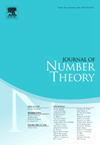Congruences modulo arbitrary powers of 5 and 7 for Andrews and Paule's partition diamonds with (n + 1) copies of n
IF 0.7
3区 数学
Q3 MATHEMATICS
引用次数: 0
Abstract
Recently, Andrews and Paule introduced a partition function which denotes the number of partition diamonds with copies of n where summing the parts at the links gives N. They also presented the generating function for and proved several congruences modulo 5,7,25,49 for . At the end of their paper, Andrews and Paule asked for determining infinite families of congruences similar to Ramanujan's classical , where and . In this paper, we give an answer of Andrews and Paule's open problem by proving three congruences modulo arbitrary powers of 5 for . In addition, we prove two congruences modulo arbitrary powers of 7 for , which are analogous to Watson's congruences for .
对(n + 1)个n拷贝的Andrews和Paule分割菱形取5和7的任意幂模的同余
最近,Andrews和Paule引入了一个配分函数PDN1(N),该配分函数表示有(N +1)个拷贝N的配分菱形的个数,其中在连杆处的部分之和为N。他们还给出了PDN1(N)的生成函数,并证明了PDN1(N)以5,7,25,49为模的几个同余。在论文的最后,Andrews和Paule要求确定类似于Ramanujan经典的p(5kn+dk)≡0(mod5k)的无穷族,其中24dk≡1(mod5k)且k≥1。本文通过证明PDN1(n)对5的任意幂取模的三个同余,给出了Andrews和Paule开问题的一个答案。此外,我们证明了PDN1(n)的两个以7的任意幂模的同余,类似于p(n)的沃森同余。
本文章由计算机程序翻译,如有差异,请以英文原文为准。
求助全文
约1分钟内获得全文
求助全文
来源期刊

Journal of Number Theory
数学-数学
CiteScore
1.30
自引率
14.30%
发文量
122
审稿时长
16 weeks
期刊介绍:
The Journal of Number Theory (JNT) features selected research articles that represent the broad spectrum of interest in contemporary number theory and allied areas. A valuable resource for mathematicians, the journal provides an international forum for the publication of original research in this field.
The Journal of Number Theory is encouraging submissions of quality, long articles where most or all of the technical details are included. The journal now considers and welcomes also papers in Computational Number Theory.
Starting in May 2019, JNT will have a new format with 3 sections:
JNT Prime targets (possibly very long with complete proofs) high impact papers. Articles published in this section will be granted 1 year promotional open access.
JNT General Section is for shorter papers. We particularly encourage submission from junior researchers. Every attempt will be made to expedite the review process for such submissions.
Computational JNT . This section aims to provide a forum to disseminate contributions which make significant use of computer calculations to derive novel number theoretic results. There will be an online repository where supplementary codes and data can be stored.
 求助内容:
求助内容: 应助结果提醒方式:
应助结果提醒方式:


